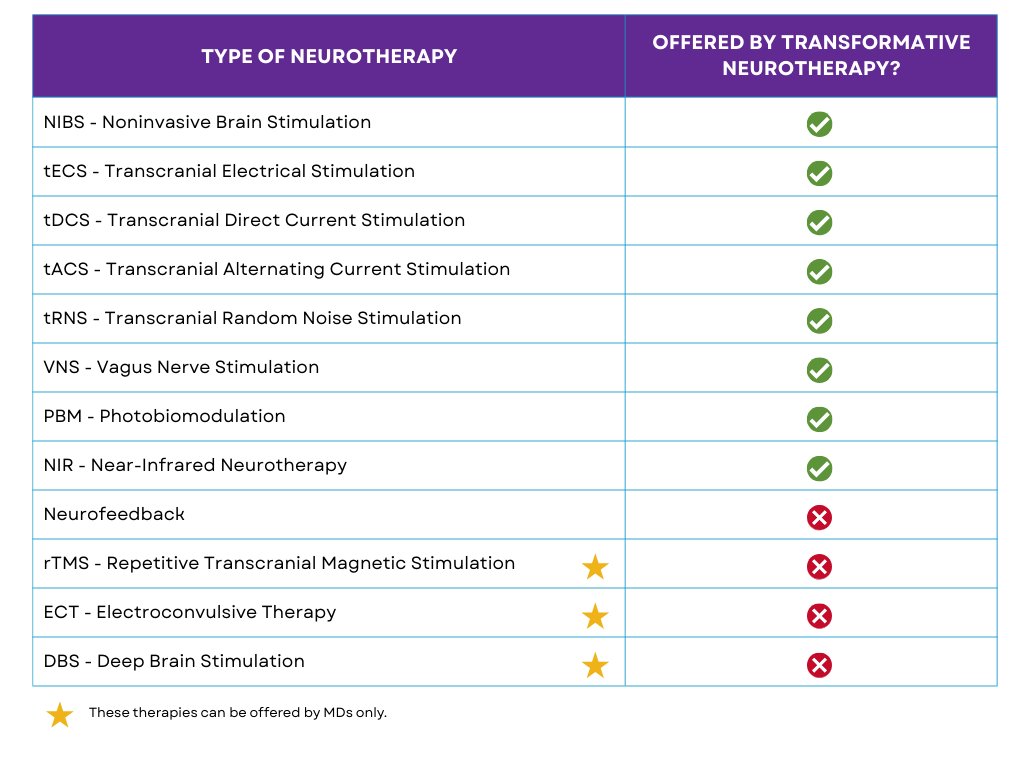FREQUENTLY ASKED QUESTIONS
Explore some common questions and answers about how neurotherapy works, the treatment process, and more!
-
Safety sits at the center of every brain-based therapy we offer—and for good reason. No one wants to trade risk for results. Our goal is to help clients feel confident that neuromodulation can be both gentle and effective when guided by science, dosing limits, and careful protocols.
At Transformative Neurotherapy, we work with three primary approaches: photobiomodulation (light therapy), pulsed electromagnetic field (PEMF), and low-intensity electrical stimulation. Each interacts with the nervous system in a unique way, but the throughline is precision. Targeted wavelengths, tuned magnetic frequencies, and controlled current keep interventions within a safety envelope supported by research.
-
It may take 10-15 sessions for a client to notice changes produced by neurotherapy, though some clients reported noticing improvements in mood or sleep from the very first treatment. Regardless of when you notice the benefits, consistent treatments will be necessary to create the long term shifts over time. After 10-20 sessions , a secondary EEG will be taken to demonstrate brain changes and adjust protocols in order to give a better estimation of the total time needed to reach treatment goals.
-
Yes, combining neuromodulation techniques with medications can offer several benefits for patients with various conditions, potentially leading to improved outcomes and quality of life:
Greater symptom control: The combination of neuromodulation and medications often provides better results than either treatment alone.
Faster and more substantial improvements: In depression treatment, combining medication with neurotherapy has shown to produce greater and quicker progress compared to monotherapy.
Synergistic effects: Neuromodulation techniques can complement medication effects, potentially addressing different aspects of a condition or targeting multiple neural pathways.
Lower medication doses: Some patients receiving neuromodulation may be able to reduce their medication doses in close consultation with their prescriber. Close coordination between prescribing physicians and the Neurostimulation team remains essential for optimal safety and efficacy. Do NOT reduce medication on your own.
Decreased side effects: Reducing medication doses can lead to fewer drug-related side effects, such as constipation or drowsiness associated with opioids.
Reduced relapse rates: Combination therapy has been shown to significantly reduce the chances of relapse in patients with depression.
Better functioning: Some clients experienced substantially improved quality of life and better functioning at work, home, or school when combining medications with neurotherapy and/or other forms of therapy.
Increased Functional dose of medication possible: Neurostimulation increases blood flow to the brain. As such, some medications cross the blood brain barrier at greater rates than they would otherwise. When engaging in Neurotherapy, clients may essentially get a higher functioning dose of the medication. If this occurs, it is possible that increased side effects of the medication may be noticed. When this occurs, it is important to consult with the prescribing doctor to consider modifying the dose.
Bikson, M., Grossman, P., Thomas, C., Zannou, A. L., Jiang, J., Adnan, T., Mourdoukoutas, A. P., Kronberg, G., Truong, D., Boggio, P., Brunoni, A. R., Charvet, L., Fregni, F., Fritsch, B., Gillick, B., Hamilton, R. H., Hampstead, B. M., Jankord, R., Kirton, A., Knotkova, H., … Woods, A. J. (2016). Safety of Transcranial Direct Current Stimulation: Evidence Based Update 2016. Brain stimulation, 9(5), 641–661. https://doi.org/10.1016/j.brs.2016.06.004
McLaren, M. E., Nissim, N. R., & Woods, A. J. (2018). The effects of medication use in transcranial direct current stimulation: A brief review. Brain stimulation, 11(1), 52–58. https://doi.org/10.1016/j.brs.2017.10.006
-
Neurotherapy intensives are focused, condensed treatments that deliver neuromodulation more frequently, aiming to accelerate neuroplasticity and potentially offer faster relief from symptoms.
Visit our Neurotherapy Intensives page for more information.
-
Yes. Clients with recent (6 weeks or less) head injuries that may have resulted in brain bleeding, including, but not limited to: any form of head trauma, concussion, and especially stroke, should consult with a neurologist before beginning neurotherapy. Since neurotherapy is known to increase blood flow to the targeted area of the brain, stressed or damaged blood vessels in the brain should be given adequate time to heal before engaging in neurotherapy.
Clients with a history of seizures should let the clinician know before engaging in neurotherapy as they may be more sensitive to certain protocols than other clients.
-
Visit our Pricing & Payment Options page for detailed information about the cost and about packages and plans that might be right for you.
-
Neurotherapy and the QEEG scan are not covered by insurance at this time.
You can use HSA (Health Savings Accounts), or apply for a Care Credit Card, which offers low or 0% interest for a period of time. This can help offset the costs of the initial assessments and treatments.
See our Pricing and Payment Options page for more information.
-
We have provided some tips to best prepare for your EEG (or brain scan) for the most accurate results. Click here to view those tips.
-
Our team has provided a list of suggestions to make the most of our neurotherapy treatments. Click here to view our recommendations.
WHAT TYPES OF NEUROTHERAPY DOES TRANSFORMATIVE NEUROTHERAPY OFFER?
“Neurotherapy” or “Neuromodulation” is a broad term for a number of different types of treatment options. We’ve outlined below what Transformative Neurotherapy does and does not currently offer.


